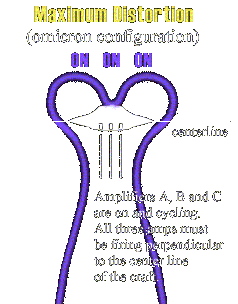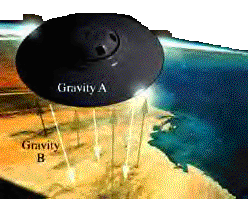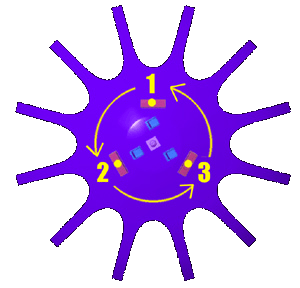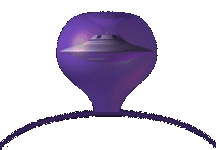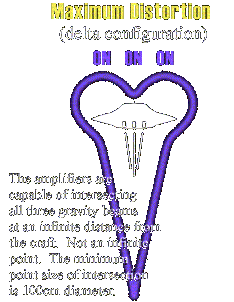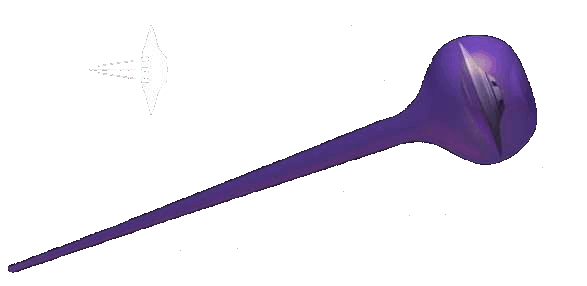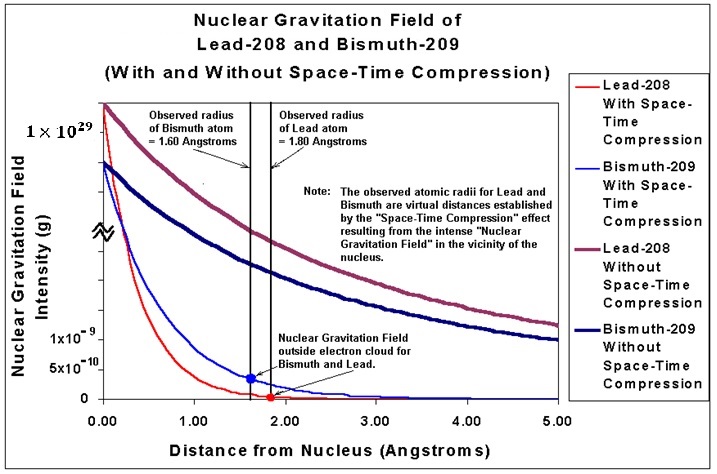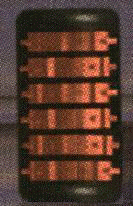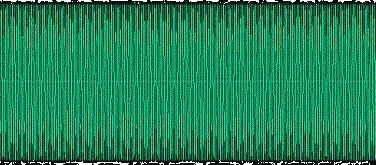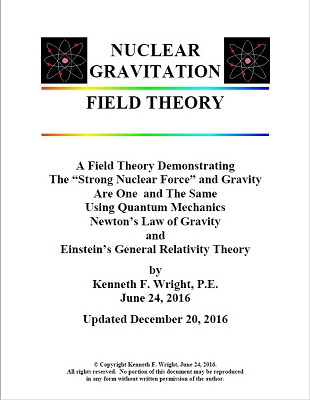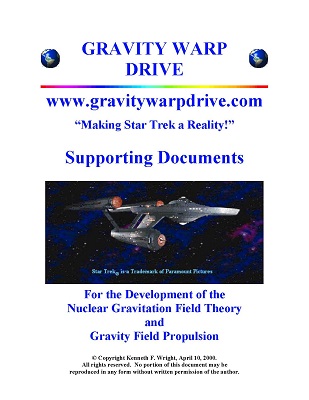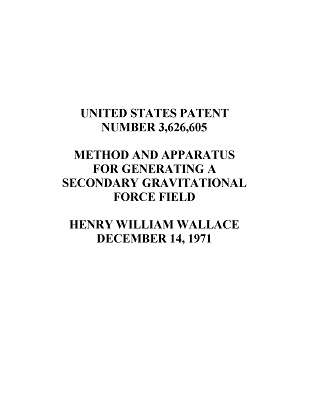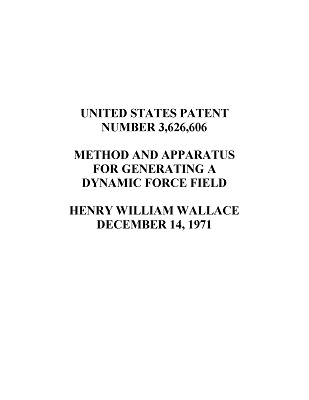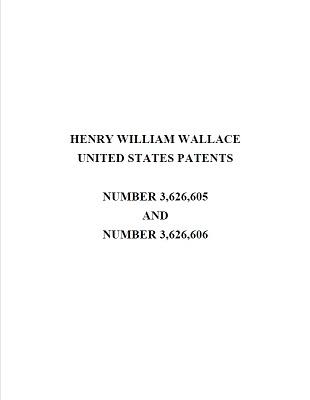by Ken Wright
TABLE OF CONTENTS
Introduction
The Real Physics of Star Trek
Subspace Communication

INTRODUCTION
In 1989 Bob Lazar went public with an incredible story. He claimed to be the senior physicist working for the United States Government on a highly classified project ... the reverse engineering of extraterrestrial spacecraft at S4 located in a remote portion of the Nevada desert approximately 15 miles southwest of Area 51 (Reference: “Government Scientist Goes Public”). He had been assigned to work on one of nine flying discs in the U.S. Government’s possession. The flying disc Bob worked on was a very sleek looking machine about 52 feet in diameter. Hence, Bob nicknamed the disc the “Sport Model.” Bob reviewed several U.S. Government documents discussing the discs, their origin, and the alien race that built them during his stay at S4. The documents stated the Sport Model Flying Disc and the other eight discs were built about 37 light years from our solar system ... on the fourth planet orbiting Zeta 2 Reticuli, a fifth magnitude star very similar to our Sun located in the southern skies. How did such a craft travel 37 light years to reach our solar system and Earth? The Sport Model most certainly did not get here by any propulsion system known to the current Physics or Engineering Communities ... at least not by any propulsion system the U.S. Government has disclosed to the general public thus far. The late Colonel Phillip Corso, in his book, “Day After Roswell,” stated the engineers examining the crashed discs at Roswell in July of 1947 were completely puzzled as to how the discs could even fly. The discs had no discernible engine of any kind.
Sport Model Flying Disc

THE REAL PHYSICS OF STAR TREK
The current Physics paradigm states that the speed of light = 186,300 miles/second is the ultimate or limiting speed. The nearest star system to our own solar system is the Alpha Centauri (Rigil Kentaurus) triple star system located about 4.37 light years distant. The light that we see from Alpha Centauri left that star system about 4 years, 4.5 months ago. Therefore, if light is the limiting speed, it would take mankind nearly 9 years to travel to Alpha Centauri and return to Earth, assuming a craft could be built to travel at near the speed of light. It is hard to believe that an extraterrestrial race of beings spent over 37 years traveling in such a small craft as the Sport Model Flying Disc from Zeta 2 Reticuli Planet 4 to our Earth. Perhaps the “Sport Model” is a shuttle craft for a much larger “mother ship” stationed somewhere within our solar system. But even if the “Sport Model” is “merely” a “shuttle craft” associated with a much larger “mother ship,” the “mother ship” still had to travel the 37 light years to get here. 37 years or greater is a long time to be cooped up aboard a ship, even a starship. When the original Star Trek aired on NBC television in the fall of 1966, the mission of the U.S.S. Enterprise (NCC-1701) was only to be “5-year mission.” I don’t think any of you could even imagine being at sea aboard a ship for 37 years. The Biblical account of the Isrealite people wandering about the Sinai Desert for 40 years, under the leadership of Moses, is the closest event of mankind that could relate to traveling through the emptiness of space for such a long period of time. The Isrealites were not at all happy about having to wander in the desert for 40 years. Therefore, the alien race must have developed a propulsion system that either was capable of “breaking the light barrier” or was capable of “warping” or “compressing Space-Time” and effectively shortening the distance of travel.
Bob Lazar claimed that the Sport Model flying disc used gravity amplification for either hovering over a planet’s or moon’s surface or for “compressing Space-Time” for interstellar space travel. Bob Lazar stated that the discs didn’t actually violate the ultimate speed limit of light; the discs “changed the rules” and circumvented that speed limit altogether by using amplified gravity to compress the distance traveled and time required for making the trip. Is this really possible? What is gravity? How does one amplify gravity? Obviously, there is more to gravity than what our Physics books currently say about it.
Cutaway of Sport Model Flying Disc
What do Physicists and Engineers currently know about gravity?
- Isaac Newton stated that the force of gravity propagating from an object is directly proportional to the mass of that object.
- Albert Einstein had postulated in his General Relativity Theory that intense gravitational fields can bend light and curve Space-Time.
- General Electric Engineer Henry William Wallace designed a mechanical device that generates a secondary gravitational force field and obtained U.S. Patent Number 3,626,605 for his design on December 14, 1971. Henry Wallace used a rapidly rotating Bismuth disc to generate the secondary gravity field. The element Bismuth has unusual gravitational properties.
- Associate Professor Tom Van Flandern performed a calculation and published it in “Physics Letters A,” titled “The Speed of Gravity - What the Experiments Say,” which demonstrated that gravity propagated at least 20 billion times faster than light and may actually propagate instantaneously.
Bob Lazar claimed that all nine discs contained the same power and propulsion system made up of a Matter/Anti-Matter Reactor containing Element 115, thermoelectric generators below the reactor, a waveguide attached to the top of the reactor, and three gravity amplifier heads and their associated gravity amplifiers. Element 115 served a dual purpose because it provided the fuel for the reactor and the source of gravity for the gravity field propulsion system. Bob Lazar claimed that the reactor amplified the “Strong Nuclear Force” (the force that holds the protons and neutrons together in the nucleus of the atom) of Element 115 to produce the “1g-force” gravity field onboard the Sport Model Flying Disc. Therefore, during space flight, astronauts on board the Flying Disc would feel as if they are standing on the Earth’s surface. They would neither experience any significant “g-forces” during rapid acceleration nor “zero-gravity” as our astronauts currently experience in conventional spacecrafts during a launch from a launch pad or while orbiting the Earth, respectively. That same ship’s internal gravity field is, then, amplified and focused by the gravity amplifiers for either hovering and propulsion above a planet surface or for “compressing Space-Time” to perform interstellar space travel. The Flying Disc hover and propulsion mode above a planet is identified as the “Omicron Mode” of operation. The Flying Disc mode for “Space-Time Compression” supporting interstellar space travel is identified as the “Delta Mode” of operation. When the Sport Model Flying Disc gravity field is at maximum distortion in either Omicron Mode or Delta Mode, the gravity field is so intense that the Flying Disc becomes invisible to any external observer. The intense gravity field is bending light around the disc in such a manner that the observer is only able to see the sky of blue or the blackness of space around the disc. If one could visually see the gravity field generated around the Sport Model Flying Disc, it would appear to be doughnut shaped as indicated by the “Disc Gravity Field” image provided below:
Maximum
DistortionDisc Gravity Field
One gravity amplifier is used to hover over the planet, the other two gravity amplifiers are used for lateral movement or to pick up items from the planet’s surface such as cattle or people.
The gravity amplifiers of the disc can be focused independently. The gravity amplifiers are pulsed in a rotational pattern and do not stay on continuously. The amplifiers pulse individually at 7.46 Hz in a continuous cycle around the disc.
Omicron Mode of Operation for Hovering
and Navigating Over a Planet
All three gravity amplifiers of the disc are focused on the same point in space and operated at maximum power to generate an intense linear gravity beam. This gravity beam is analogous to the intense coherent light beam of a LASER. The intense linear gravity beam produces maximum “Space-Time Compression” reducing the travel distance between star systems from several light-years (several tens to hundreds of trillions of miles) to only several million miles, a very short distance to travel, relatively. Once the disc reaches its final destination, the intense linear gravity field is removed and Space-Time returns to its normal configuration. The disc is now several light-years from its previous location, the trip only taking minutes, hours, or days, instead of hundreds of thousands of years.
Delta Mode of Operation for Space-Time Compression
and Interstellar Space Travel
When operating in Delta Mode, the disc travels at “sub-light speed” within a “wormhole” or “black tunnel” generated by the “Compressed Space-Time” gravity beam. I call it a “black tunnel” because light cannot escape the tunnel formed by the intense gravity beam. Relative to an observer outside the “Compressed Space-Time” gravity beam, the disc is invisible and is effectively traveling thousands of times faster than light. The disc is only traveling “sub-light speed” relative to the “Compressed Space-Time” distance it must travel. In fact, if the disc was to turn on a spotlight and point it in the direction of travel, the resulting beam of light would propagate from the disc at the speed of light relative to the disc. If the disc was 93,000,000 miles (Earth-Sun distance) from its destination in “Compressed Space-Time,” the light beam would reach the destination in 8 minutes 19 seconds.
NOTE: In my “Nuclear Gravitation Field Theory,” I discussed how the propagation of the Nuclear Electric Field wave established by the protons in the nucleus of the atom is determined by the virtual “Compressed Space-Time” distance from the nucleus. Light, or electromagnetic radiation, includes both an electric field and magnetic field as it propagates through space. Light propagates in “Compressed Space-Time” in the same way the Nuclear Electric Field propagates in Compressed Space-Time in the vicinity of the nucleus of the atom. The Nuclear Gravitation Field (Strong Nuclear Force) propagates based upon Uncompressed Space-Time, therefore, appears to vanish at the surface of the nucleus because it drops over 19 decades in intensity before having any apparent propagation outward from the nucleus as we see in Compressed Space-Time. An intense gravitational field is not the only way to produce “Space-Time Compression.” Albert Einstein’s General Relativity Theory deals with relativity associated with any assumed accelerated reference frame. Any accelerated reference frame can experience the effect of “Space-Time Compression” as long as the acceleration rate is significant enough. The effect of “Space-Time Compression” can be experienced by a spacecraft undergoing acceleration by the thrust of a rocket engine or experienced by a charged particle accelerated in an intense electric field as well as any mass subjected to an acceleration produced by an intense gravity field. Why is a gravity field propulsion system the only feasible propulsion system for interstellar space travel? A gravity field acts upon all objects of mass and accelerates them at the same acceleration rate. An electric field only acts upon charged particles to accelerate them. A rocket engine only acts upon the rocket it is installed within and the payload spacecraft the rocket is connected to. Let’s assume there are astronauts aboard a spacecraft accelerating through interstellar space with an acceleration rate of 10,000 g. If that acceleration rate is produced by a rocket engine connected to the spacecraft, the astronauts are not directly accelerated by the rocket engine. The astronauts will be accelerated by the normal force of 10,000 g applied to them by the seats connected to the spacecraft they are strapped into. Such an intense acceleration rate will flatten the astronauts like pancakes. Additionally, the fuel consumption required for such a rocket propulsion system is extremely large and storage of the fuel for interstellar space travel would be virtually impossible. If it were possible to make the spacecraft positive charged and accelerate it at 10,000 g in an electric field established between two large charged plates, the positive plate in the solar system the spacecraft is coming from and the negative plate in the solar system the spacecraft is going to, the astronauts would still be flattened like pancakes within their seats because the astronauts are neutral in charge and the electric field does not act directly upon the astronauts. Such a propulsion system with electric plates would be extremely impractical to build and maintain. How does one build the negative plate in the solar system one wants to go to without being able to travel there in the first place? If we have already accomplished the feat of traveling to that solar system prior to building the negative plate at that solar system, then there would be no longer a reason to build it there.
A gravity field propulsion system is the only practical propulsion system for interstellar space travel. A linear gravity field can be, theoretically, produced by the spacecraft. Since a gravity field acts upon the astronauts’ bodies in the same manner that gravity field acts upon the spacecraft, both the spacecraft and the astronauts are accelerated by the same gravity field at the same rate. The astronauts and their spacecraft are both in “free-fall” within the gravity field no matter what acceleration rate the gravity field produces. Therefore, the astronauts and their spacecraft could be accelerated at any acceleration rate without any personnel discomfort. The astronauts will not experience any “g-force” because their bodies are subjected to the same acceleration field as the spacecraft is (in like manner to a spacecraft in orbit around the Earth since Earth’s gravity field accelerates both the spacecraft and the astronauts equally). A “g-force” only exists if a normal force is applied to a body opposing the gravitational acceleration field. The Earth’s surface provides the normal force opposing the gravitational acceleration field of the Earth, thus providing “a measured 1 g force” applied to the body. Assuming the spacecraft power system provides a normal 1 g gravity field within the spacecraft to give the astronauts the same sensation as standing on Earth’s surface, the astronauts would have no sensation of any other acceleration no matter how intense a gravity field is produced by the spacecraft propulsion system. This is exactly why any Earth built aircraft or spacecraft is completely outmaneuvered by a flying disc utilizing a gravity field propulsion system. The following link will provide a video clip of an Unidentified Flying Object (UFO) caught on tape hovering in the vicinity of the New York City World Trade Center (prior to “911”). This video clip demonstrates the maneuverability of a craft utilizing a gravity field propulsion system. Note the rapid rates of acceleration and the capability to change direction of motion instantly. This video clip file is about 5.2 Megabytes in size. If you have a dial-up Internet service with a 56K modem, the video clip will take about 10 minutes to download. This video clip has been provided courtesy of the Syfy Channel and the Syfy Website Syfy: Imagine Greater | Syfy.
Let’s assume that an observer on Earth watched the disc or spacecraft take off from the Earth’s surface, ascend into space, and enter its gravity field propulsion system generated “black tunnel.” The observer would see the spacecraft come to a virtual stop just short of the location where the spacecraft entered its self generated “black tunnel” or “wormhole.” The disc would appear to “Doppler red-shift” and shrink in size out of visible existence. The visible image of the disc is only a virtual image at the entrance to the “black tunnel” once the disc has entered the “black tunnel.” The effect the observer sees would be similar to what an observer outside the Schwartschild Radius, or Event Horizon, of a Black Hole would see as he or she watches a spacecraft passing through the Black Hole Event Horizon toward the Black Hole. The observer sees the spacecraft come to a stop just short of the Black Hole Event Horizon and then “doppler red-shift” out of visible existence. In actuality, the ship crosses the Event Horizon and is “vacuumed” into the Black Hole to end its fateful trip.
As stated previously, Bob Lazar claimed that the Sport Model Flying Disc amplified the “Strong Nuclear Force” of Element 115 Moscovium (Mc) to generate the gravity field for “Space-Time Compression.” Physicists who have critiqued Bob Lazar’s claims say he is talking meaningless “Star Trek” techno-babble science fiction which has nothing to do with reality. Physicists state that the “Strong Nuclear Force” and the force of gravity have nothing to do with each other because gravity is a weak force and cannot overcome the much stronger electrostatic repulsion of the protons in the nucleus. All the protons in the nucleus are of positive (+) charge and repel each other electrostatically. When a calculation is performed to determine the minimum gravitational acceleration field to overcome the Coulombic Repulsion of Protons in the Nucleus, the result indicates the gravitational acceleration must be at least 2.441 x 1027g, a field that rivals a Neutron Star or Black Hole. The resultant intense Space-Time Compression Next to the Nuclear Surface results in the Nuclear Gravitational Field dropping at least 19 decades in intensity before turning outward to leave the atom. Neutrons are also required in the nucleus when multiple protons are present to provide additional gravitational attraction and fill available nuclear energy level quantum numbers because the Space-Time Compression within the Nucleus results in the apparent “saturation” of the “Strong Nuclear Force.” Quantum Mechanics and General Relativity describes the observed effects associated with the Nucleus if the “Strong Nuclear Force” is Gravity. My “Nuclear Gravitation Field Theory” discusses the effects of Gravity and Space-Time Compression if the “Strong Nuclear Force” is assumed to be gravity.
Since the “Strong Nuclear Force” and gravity are the same force, Bob Lazar’s claim that the “Strong Nuclear Force” of a stable isotope of Element 115 Moscovium was used to provide the Sport Model Flying Disc gravity field propulsion system may very well be true. One problem! There are no known stable Elements above Element 83, Bismuth. Physicists have only recently produced two isotopes of Element 115 Moscovium in a nuclear reaction on Earth and Element 115 Moscovium has never been found in nature. On February 2, 2004, scientists at the Lawrence Livermore National Laboratory, in collaboration with researchers from the Joint Institute for Nuclear Research in Russia (JINR), announced that they discovered two new super-heavy elements, Element 113 Nihonium and Element 115 Moscovium. The isotopes of Element 115 Moscovium, produced by bombarding an Americium-243 (95Am243) nucleus with a Calcium-48 (20Ca48) nucleus, 115Mc287 and 115Mc288, rapidly decayed to Element 113 Nihonium, then continued to decay until a meta-stable isotope was obtained. Neither of the isotopes of Element 115 produced in the nuclear reactions were, obviously, the stable isotope of Element 115 used as the fuel in the “Sport Model Flying Disc.” Hold on now! Before you discredit Bob Lazar’s claims, consider the following. In addition to the isotopes of Element 115 Moscovium produced on Earth, Physicists have produced three identified isotopes of Element 114 Flerovium (Fl) in various nuclear reactions. Element 114 Flerovium contains 114 protons, by definition, and the number, 114, is a “magic number” for protons. Magic numbers represent the required number of nucleons to completely fill the energy levels of the nucleus. The magic numbers for protons are 2 (Helium), 8 (Oxygen), 20 (Calcium), 28 (Nickel), 50 (Tin), 82 (Lead), and 114 (Flerovium). The applicable Elements containing proton magic numbers are indicated in the excerpt from the Periodic Table of the Elements, below, with a red box around them. The magic numbers for neutrons are 2, 8, 20, 28, 50, 82, 126, and 184. The three Element 114 Flerovium isotopes produced contained 171 neutrons which lasted 58 milliseconds, 174 neutrons which had a half-life of 2 seconds, and 175 neutrons which had a half-life of 30 seconds. For Element 114 Flerovium to be “double magic” it would have to contain 184 neutrons. The isotope of Element 114 Flerovium with 175 neutrons, short 9 neutrons from being a “double magic” nucleus, had a half-life of 30 seconds. A 30 second half-life is a relatively long half-life for such a superheavy element. Based upon this observed data, it is very likely that the “double magic” isotope of Element 114 Flerovium with 184 neutrons would be a stable nucleus. So what? What does that have to do with Element 115 and its stability? Let’s look at Element 83, Bismuth – specifically, the only stable isotope of Bismuth – Bismuth-209 (83Bi209). Recall that Henry William Wallace patented a device that generates a secondary gravitational force field which used a rapidly rotating Bismuth disc. The nuclear configuration of Bismuth-209 is very unique. The only stable isotope of Bismuth has 126 neutrons. Lead is Element 82. 82 is the magic number for protons filling 6 proton energy levels. 126 neutrons is a magic number for neutrons filling 7 neutron energy levels. The isotope of Lead that contains 126 neutrons, 82Pb208 is a “double magic” nucleus. Since Bismuth is Element 83, it has one extra proton that must go into the 7th energy level for protons, because 82 protons completely fill 6 proton energy levels. Bismuth has 126 neutrons, the magic number for neutrons, which, as previously noted, completely fills 7 neutron energy levels.
Periodic Table of the Elements - p-Orbitals 13 14 15 16 17 18 p-Orbitals
1
H
2
He5
B6
C7
N
8
O9
F10
Ne13
Al14
Si15
P16
S17
Cl18
Ar31
Ga32
Ge33
As34
Se35
Br36
Kr49
In
50
Sn51
Sb52
Te53
I54
Xe81
Tl
82
Pb83
Bi84
Po85
As86
Rn113
Nh
114
Fl115
Mc116
Lv117
Ts118
OgReference: http://www.webelements.com/index.html
Table of the Nuclides - Lead and Bismuth 85
AtAt208 At209 At210 At211 At212 At213 At214 84
PoPo207 Po208 Po209 Po210 Po211 Po212 Po213 83
BiBi206 Bi207 Bi208 Bi209 Bi210 Bi211 Bi212 82
PbPb205 Pb206 Pb207 Pb208 Pb209 Pb210 Pb211 81
TlTl204 Tl205 Tl206 Tl207 Tl208 Tl209 Tl210 80
HgHg203 Hg204 Hg205 Z ↑
N →123 124 125 126 127 128 129 Reference: http://www.nndc.bnl.gov/chart/
A “double magic” isotope of Element 114 Flerovium would have 114 protons filling 7 proton energy levels and 184 neutrons filling 8 neutron energy levels. Element 115 Moscovium has one extra proton that must go into the 8th proton energy level because 114 protons completely fill 7 proton energy levels. The potentially stable isotope of Element 115 Moscovium will have 184 neutrons, the “magic number” for neutrons filling 8 neutron energy levels. The nuclear configuration for Element 83 Bismuth (83Bi209) and Element 115 Moscovium (115Mc299) are identical with the exception that Element 115 Moscovium has one more energy level filled with protons and neutrons. Element 83 Bismuth is the highest number element that is “officially identified” to be stable. All known elements above Element 83 are radioactive and undergo decay to other elements. If the “double magic” isotope of Element 114 Flerovium with 184 neutrons is a stable element, then Element 115 Moscovium with a “magic number” of 184 neutrons and only one lone proton in its outer proton energy level could very well be a stable element, just as Bismuth-209. The two isotopes of Element 115 Moscovium recently produced in nuclear reactions, 115Mc287 with 172 neutrons and 115Mc288 with 173 neutrons, are shy 12 neutrons and 11 neutrons, respectively, of the magic number of 184 neutrons. There are no other identified stable isotopes of any elements with a nuclear configuration similar to Element 83 Bismuth or Element 115 Moscovium. If Bismuth has unique gravitational characteristics, it would be very reasonable to expect Element 115 Moscovium to have those same unique gravitational characteristics. Because Element 115 Moscovium is 1.43 times more massive than Element 83 Bismuth, its gravitational field should be even stronger than Bismuth’s. The following table provides the fill of the various energy levels within the nucleus for protons and neutrons for Lead, Bismuth, Element 114 Flerovium, and Element 115 Moscovium.
Nucleon Energy Levels for Lead, Bismuth, Element 114, and Element 115 Energy
Level1
(He)2
(O)3
(Ca)4
(Ni)5
(Sn)6
(Pb)7
(Fl)8
(E164)Total
Protons
and
Neutrons“Double Magic” Lead (Element 82) Protons
Lead
(82Pb208)
Neutrons2p
2n6p
6n12p
12n8p
8n22p
22n32p
32n
44n82p
126nBismuth (Element 83) With a “Magic Number” of Neutrons Protons
Bismuth
(83Bi209)
Neutrons2p
2n6p
6n12p
12n8p
8n22p
22n32p
32n1p
44n83p
126nTheoretical “Double Magic” Element 114 Flerovium Protons
E114
Flerovium
(114Fl298)
Neutrons2p
2n6p
6n12p
12n8p
8n22p
22n32p
32n32p
44n
58n114p
184n“Sport Model” Flying Disc Element 115 Moscovium With a “Magic Number” of Neutrons Protons
E115
Moscovium
(115Mc299)
Neutrons2p
2n6p
6n12p
12n8p
8n22p
22n32p
32n32p
44n1p
58n115p
184nReference: http://www.nndc.bnl.gov/chart/
My “Nuclear Gravitation Field Theory” states that the “Strong Nuclear Force” and gravity are the same force. The unique nuclear configuration of Bismuth and Element 115 result in the unique gravitational properties of these two elements. The one lone proton in the outer energy level results in the “Strong Nuclear Force,” or “Nuclear Gravitation Field,” next to the nucleus being significantly weaker than for the nuclei of other stable atoms. The weaker “Nuclear Gravitation Field” reduces the amount of “Space-Time Compression” that occurs next to the nucleus than for the nuclei of other stable atoms. The electrons positions in their “orbitals” around the nucleus are based upon the electric field strength and wavelength. The electron “orbitals” around the nucleus are determined by the “Compressed Space-Time” distance from the nucleus. Therefore, the electron “orbitals” will not be positioned farther away from the nucleus if the “Compressed Space-Time” from the nucleus is less significant. This phenomenon results in a higher intensity “Strong Nuclear Force,” or gravity field, outside the electron cloud. The following image from my “Nuclear Gravitation Field Theory” provides a graphical comparison of the Nuclear Gravitation Fields of Lead-208 and Bismuth-209 as a function of distance from the nucleus in Angstroms. The graphs illustrate the virtual radii of each of the atoms based upon “Space-Time Compression” and the effective radii of the atoms if “Space-Time Compression” effects were not present. My “Nuclear Gravitation Field Theory” discusses the gravitational characteristics of Bismuth in greater detail.
Nuclear Gravitation Field of Lead-208 and Bismuth-209
(With and Without Space-Time Compression)
NOTE 1: The figure, above, only provide “ballpark” values for the “Nuclear Gravitation Field Intensity” of Lead-208 and Bismuth-209 in units of “g-force” as a function of distance from the nucleus. In order to calculate exact values for the Nuclear Gravitation Field intensity, a very sophisticated computer program must be used to perform the iterative calculation required with the Schrodinger Wave Equation to include the effects of General Relativity (i.e., “Space-Time Compression”) with Quantum Mechanics. The intent of the graphs is only to provide a relative visual representation of the Nuclear Gravitation Field as a function of distance from the nucleus. The Nuclear Gravitation Field intensity curves for Lead-208 and Bismuth-209 “without Space-Time Compression” are proportional to a 1/r2 function where r is the radial distance from the nucleus. The curves accounting for “Space-Time Compression” have a correction factor for the Nuclear Gravitation Field intensity as a function of distance, which is a function of the Nuclear Gravitation Field intensity. The distance from the nucleus is, therefore, compressed. The Nuclear Gravitation Field intensity at the nuclear surface is on the order of 1027 times to 1029 times greater than the Nuclear Gravitation Field intensity in the proximity of the end of the electron cloud, which represents the atomic radius. Neither a purely logarithmic nor a purely linear scale would be practical for indicating the relative Nuclear Gravitation Field strength as a function of distance from the nucleus of the atom. The vertical scale depicting “Nuclear Gravitation Field Intensity” is quasi-linear at the bottom the graph near the origin, becomes logarithmic as it moves away from the origin, then becomes quasi-linear at the top of the graph. NOTE 2:
The difference in the Nuclear Gravitation Field Intensity between 82Pb208 and 83Bi209 is grossly exaggerated in order to illustrate how reducing the intensity of the Nuclear Gravitation Field in the vicinity of the nucleus of an atom will produce a greater intensity gravity field at the outside of the electron cloud of that atom. If Bismuth had such a large gravitational attraction outside its electron cloud relative to Lead, spheres of Bismuth would fall about 10 times faster than Lead. In actuality, the gravitational field of Bismuth outside its electron cloud is only a small percentage greater than the gravitational field of Lead outside its electron cloud.
Since the “Strong Nuclear Force” of Bismuth-209 or Element 115 (Moscovium-299) is significantly weaker next to the nucleus than for the nuclei of other stable atoms where mass has already been considered, the residual “Strong Nuclear Force” of Bismuth-209 or Element 115 (Moscovium-299) propagating out of the electron cloud of the atom is stronger than for other stable atoms. That stronger gravity field outside the electron cloud of the atom can be more easily accessed and amplified. Therefore, Bismuth-209 and Element 115 (Moscovium-299) are the best candidate elements to be used as a source of gravity for a gravity field propulsion system. The Reticulan Greys obviously knew their nuclear physics when they designed the power and propulsion system for the Sport Model Flying Disc.
Cavendish Experiments can be performed to demonstrate that Bismuth-209 has a stronger gravitational field beyond that associated with its mass than the gravitational field of Lead-208. The Cavendish Experiment was used to determine G in Newton’s Law of Gravity equation:

Refer to my discussion on the measurement of the “Universal Gravitation Constant, G,” by performing the Cavendish Experiment for Lead-208 and Bismuth-209 in my Nuclear Gravitation Field Theory.
Bob Lazar claimed to have observed the Sport Model Flying Disc in flight. Before ascending, the Sport Model briefly gave off a corona discharge, a sound similar to that of high-voltage electricity, and then it became completely silent, its bottom glowing blue. The hissing and glowing are by-products of the tremendous electromagnetic pulses generated from the craft. He was given a short demonstration of its maneuvering capability. The disc ascended about 30 feet off the ground, moved to the left, then to the right, and then ascended rapidly. The intense eletromagnetic field generated by the gravity amplifers amplify the gravity field produced by the Element 115 in the Sport Model Matter/Anti-Matter Reactor. As indicated by the “Cutaway View of the Sport Model Flying Disc” image above and the “Gravity Amplifier” image below, the current conducting “core plates” on the gravity amplifiers for the Sport Model Flying Disc have a very large current carrying capacity based upon their significant size.
Gravity Amplifier
Although many Physicists try to debunk Bob Lazar’s story, there is certainly plenty of scientifically accepted physical evidence that supports his claims. Quantum Physics, Nuclear Physics, and General Relativity provide the justification for the physics behind the propulsion system and interstellar travel of the Sport Model Flying Disc. If mankind were to focus energy and resources on developing a similar designed spacecraft, I believe the “Science Fiction” of Star Trek can become “Science Fact” in the very near future. By some of the information I have heard through the years, mankind may already be traveling through interstellar space via craft built by the U.S. Government under one of those Top Secret Black Projects that is not supposed to even exist. There is certainly enough evidence to indicate the U.S. Government has the technology in hand, anyway.
The following referenced information discusses the observed scientific evidence supporting the Nuclear Gravitation Field Theory. The observed gravitational characteristics of Bismuth demonstrate the “Strong Nuclear Force” and Gravity are one and the same.
RS Electrogravitic References: Part 7 of 19
When individual molecules are not permanently magnetized, it is possible in some cases to have a relative magnetic permeability, μ, which is less than one. Such a material, like hydrogen or BISMUTH, is called diamagnetic. It tends to expel magnetic field, and is repelled from regions of stronger magnetic field. The names paramagnetic and diamagnetic are sometimes confused. Paramagnetic is analogous to a dielectric in an electric field, while diamagnetic is quite the opposite. It is not possible to give a simple argument of why diamagnetism can occur. It is strictly speaking a quantum effect. However, one can see that there might be diamagnetic tendencies if electric currents can flow within molecules. An increasing magnetic field always tends to induce currents to flow in such a way as to tend to prevent the increase in the field. This is (at least temporarily) a diamagnetic kind of effect. Thus the case where the relative magnetic permeability, μ < 1, is connected with the flow of electric charges in a magnetic field. There is no analogous case with electric fields since isolated magnetic poles do not, so far as is known, exist.
-- “The New Physics” edited by Paul Davies
GE engineer Henry William Wallace found unusual gravitational affects in spinning odd atomic nuclide metals. Odd atomic nuclide metals are those in which the sum of the protons are not equal to the number of neutrons, i.e., more neutrons. See U.S. Patents 3,626,605 and 3,626,606.
-- Ron Kita
Reference: http://www.padrak.com/ine/RS_REF7.html
“Since the dynamic interaction field arising through gravitational coupling is a function of both the mass and proximity of two relatively moving bodies, then the resultant force field is predictably maximized within the nucleus of an atom due to the relatively high densities of the nucleons plus the fact that the nucleons possess both intrinsic and orbital components of angular momentum. Such force fields may, in fact, account for a significant portion of the nuclear binding force found in all of nature.”
References:
United States Patent Number 3,626,605, “Method and Apparatus for Generating a Secondary Gravitational Force Field” United States Patent Number 3,626,606, “Method and Apparatus for Generating a Dynamic Force Field” “Also indicated in the embodiment of FIGURES 7A* and 7B* is the orientation of the flux within the mass circuit, the latter being constructed preferredly of BISMUTH.”
Reference:
United States Patent Number 3,626,605, “Method and Apparatus for Generating a Secondary Gravitational Force Field”
NOTE:
FIGURES 7A* and 7B* mentioned in the text are illustrations included with Henry William Wallace's description of his invention - the machine designed to generate a secondary gravitational force field - within the U.S. Patent Number 3,626,605 document. -- Henry William Wallace
Reference:
United States Patent Number 3,626,605, “Method and Apparatus for Generating a Secondary Gravitational Force Field” Bismuth is also mentioned in the literature as being electrogravitic. Spinning discs of Bismuth (patented by GE Engineer Henry William Wallace: U.S. Patent #3,626,605, U.S. Patent #3,626,606, and U.S. Patent #3,823,570) have apparently been shown to DEFY GRAVITY. Bismuth, with a strong positive electrostatic charge applied to it, has also been shown to actually lose weight, right down to ZERO. Spheres of Bismuth, when dropped, have reportedly fallen faster than they are supposed to (according to Newton's Law of Gravity).
Bismuth spheres falling faster than predicted by Newton's Law of Gravity, Henry William Wallace's speculation of a possible connection between the force of Gravity and the “Strong Nuclear Force,” and rotating Bismuth discs generating secondary gravitational force fields provide the evidence the “Strong Nuclear Force” and Gravity are one and the same. Since the “Strong Nuclear Force” is weaker in Bismuth because of the “lone 83rd proton” in the 7th nuclear proton energy level, less “Space-Time Compression” takes place in the vicinity of the 83Bi209 nucleus. The intensity of the “Strong Nuclear Force” extending outside the Bismuth atom is significant enough to provide a measurable gravitational attraction with greater intensity than predicted by Newton's Law of Gravitation. Two separate gravitation constants exist that are associated with the nucleus. The first gravitation constant is directly related to the Nuclear Gravitation Field at the surface of the nucleus. This constant is directly related to the “Binding Energy per Nucleon” for the nucleons in the outermost ground state nuclear energy levels and the “Strong Nuclear Force” intensity at the surface of the nucleus. The second gravitation constant, which has been the assumed “Universal Gravitation Constant,” “G,” is the constant associated with the gravitational field propagating outside the atom. This second constant actually varies from isotope and element to isotope and element based upon the “Binding Energy per Nucleon” for the outermost ground state energy levels in the nucleus. The first and second gravitation constants are quasi-inversely proportional because of the General Relativistic effects of “Space-Time Compression” in the vicinity of the nucleus.
Physicists have believed that there may be an island of stability in the vicinity of Element 114 (UnUnQuadium or UUQ), currently named Flerovium (Fv), in a sea of instability for the “superheavy elements” in the Table of the Nuclides. 114 protons is a proton magic number. It is very possible that an isotope of Element 114 Flerovium containing a neutron magic number of 184 neutrons could exist as a stable isotope. This Element 114, Flerovium (Fv), isotope would be “double magic” in like manner to 82Pb208. An isotope of Element 114 Flerovium with 175 neutrons (114UUQ289) has been identified by the Lawrence-Berkeley Laboratories having a half-life of 30 seconds (Reference: “Pushing the Limits of the Periodic Table,” Gina Stafford, The Knoxville News-Sentinel). A 30-second half-life doesn't seem to be a significant period of time. However, 30 seconds is a relative eternity compared to the half-lives of the elements between Element 100 and Element 109, which are on the order of milliseconds to microseconds.
The nuclear reaction producing the Element 114 isotope 114Fl289 containing 175 neutrons with a 30 second half-life is provided below:
94Pu244 + 20Ca48 → 114Fl289 + 30n1
The nuclear reaction producing the Element 114 isotope 114Fl288 containing 174 neutrons with a half-life of 2 seconds is provided below:
94Pu244 + 20Ca48 → 114Fl288 + 40n1
The Element 114 Flevorium isotope 114Fv285 containing 171 neutrons was identified as one of the intermediate product elements in a decay chain after an isotope of Element 118 (UnUnOctium or UUO), currently named Oganesson, 118Og293, was produced by the following nuclear reaction:
82Pb208 + 36Kr86 → 118Og293 + 0n1
This Element 118 Oganesson isotope, 118Og293, alpha decayed (alpha decay is a nuclear decay process that liberates a Helium nucleus, 2He4, from the parent nucleus) to become Element 116 (UnUnHexium or UUH), currently named Livermorium (Lv), isotope 116Lv289 in 12 milliseconds. The Element 116 Livermorium isotope, 116Lv289, alpha decayed to become the Element 114 Flevorium isotope, 114Fl285 in 0.60 milliseconds. This Element 114 Flerovium isotope, 114Fv285, existed for only 0.58 milliseconds before alpha decaying to become Element 112 (UnUnBium or UUB), currently named Copernicium, isotope 112Cn281. The alpha decay process continued until “the final product of the decay chain,” an isotope of an element that was “relatively stable,” was obtained.
Reference: http://www.webelements.com/webelements/elements/text/Uuq/key.html
The next neutron magic number beyond 126 is 184. The Element 114 Flerovium isotope containing 175 neutrons has a relatively long half-life for a nucleus short of 9 neutrons in its 8th neutron energy level. Assuming 184 is the next magic number for neutrons, a stable isotope of Element 114 Flerovium containing 184 neutrons, designated 114Fl298, could exist and would be expected to have an atomic mass of approximately 298 Atomic Mass Units (AMU). The probability of a stable “double magic” isotope of Element 114 Flerovium, 114Fv298, appears to be quite high considering the 0.58 millisecond life of the isotope 114Fl285, which is short 13 neutrons from the “double magic” nuclear configuration, the 2 second half-life of isotope 114Fl288, which is short 10 neutrons from the “double magic” nuclear configuration, and the 30 second half-life of the isotope 114Fl289, which is short 9 neutrons from the “double magic” nuclear configuration. The half-lives of the Element 114 isotopes are rising very significantly as the number of neutrons in the Element 114 Flerovium isotopes approaches the neutron magic number of 184.
Likewise, there may be a stable isotope of Element 115 (UnUnPentium or UUP), a “proton magic number plus one” element, containing a neutron magic number of 184 similar in nuclear configuration to 83Bi209. This isotope of Element 115 (UnUnPentium or UUP) would have an atomic mass of approximately 299 AMU and would be designated 115UUP299. Element 115 is expected to be approximately 1.43 times more massive than Bismuth and would have a smaller “Binding Energy per Nucleon” for the nucleons in the outer ground state energy levels than Bismuth. Therefore, Element 115 should have a greater gravitational field outside the atom than Bismuth. This isotope of Element 115, if it is either discovered or synthesized, should provide gravitational properties exceeding that of 83Bi209. Table “Nucleon Energy Levels for Lead, Bismuth, Element 114, and Element 115”, above, provides the numbers of protons and neutrons that fill each energy level of the nucleus for 114Fl298 and 115UUP299.
Nucleon Energy Levels for Other Nuclei of Interest Energy
Level1
(He)2
(O)3
(Ca)4
(Ni)5
(Sn)6
(Pb)Total
Protons
and
Neutronsprotons
Helium
(2He4)
neutrons2p
2n2p
2nprotons
Lithium
(3Li7(6))
neutrons2p
2n1p
2n
(1n)3p
(3n)
4nprotons
Oxygen
(8O16)
neutrons2p
2n6p
6n8p
8nprotons
Fluorine
(9F19)
neutrons2p
2n6p
6n1p
2n9p
10nprotons
Calcium
(20Ca40)
neutrons2p
2n6p
6n12p
12n20p
20nprotons
Scandium
(21Sc45)
neutrons2p
2n6p
6n12p
12n1p
4n21p
24nprotons
Nickel
(28Ni58(60))
neutrons2p
2n6p
6n12p
12n
(12n)
10n28p
(32n)
30nprotons
Copper
(29Cu63(65))
neutrons2p
2n6p
6n12p
12n8p
8n1p
(8n)
6n29p
(36n)
34nprotons
Tin
(50Sn120(118)
50Sn((116)))
neutrons2p
2n6p
6n12p
12n8p
8n22p
22n
((16n))
(18n)
20n50p
((66n))
(68n)
70nprotons
Antimony
(51Sb121(123))
neutrons2p
2n6p
6n12p
12n8p
8n22p
22n1p
(22n)
20n51p
(72n)
70nReference: http://www.nndc.bnl.gov/chart/
The proton magic numbers and their associated elements, as indicated in Table “Nucleon Energy Levels for Lead, Bismuth, Element 114, and Element 115”, above, and Table “Nucleon Energy Levels for Other Nuclei of Interest”, above, are 2 for Helium, 8 for Oxygen, 20 for Calcium, 28 for Nickel, 50 for Tin, 82 for Lead, and 114 for Flerovium. The most abundant isotopes of Helium, Oxygen, and Calcium are 2He4, 8O16, and 20Ca40. All these isotopes are “double magic.” Could other stable isotopes of elements containing a “proton magic number plus one” and containing a neutron magic number similar to Bismuth exist? The other elements that are “proton magic number plus one” are Lithium (Element 3), Fluorine (Element 9), Scandium (Element 21), Copper (Element 29), and Antimony (Element 51). Table “Nucleon Energy Levels for Other Nuclei of Interest”, above, provides the logic of nuclear energy level fill for both the “proton magic number” elements and the “proton magic number plus one” elements. The most stable isotopes of Lithium, Fluorine, Scandium, Copper, and Antimony do not contain neutron magic numbers. 93% of Lithium is 3Li7, which contains 2 neutrons in the 3rd (outer ground state) neutron energy level. 7% of Lithium is 3Li6, which contains only one extra neutron in the 3rd neutron energy level. Lithium has a rather small atomic mass so its overall contribution to a gravitational field would be small. Lithium is a very reactive alkali metal and is rather hazardous to work with for performing gravitational anomaly measurements. Fluorine, 9F19, contains 2 neutrons in the 3rd (outer ground state) neutron energy level. Fluorine has a rather small atomic mass so its overall contribution to a gravitational field would be small. Fluorine is a halogen gas at room temperature and is difficult and hazardous to work with for performing gravitational anomaly measurements. Scandium, 21Sc45, contains 4 neutrons in the 4th (outer ground state) neutron energy level. The two most abundant isotopes of Copper, 29Cu63 and 29Cu65, contain 6 or 8 neutrons, respectively, in the 5th (outer ground state) neutron energy level. The two most abundant isotopes of Antimony, 51Sb121 and 51Sb123, contain 20 or 22 neutrons, respectively, in the 6th (outer ground state) neutron energy level. Antimony's 6th neutron energy level contains about 2/3 full capacity of neutrons because the 6th neutron energy level holds 32 neutrons. Each of these “proton magic number plus one” element isotopes have additional neutrons in unfilled outer ground state energy levels. The nuclear binding of the lone proton in the outer ground state proton energy level is expected to be stronger than 83Bi209 (Bismuth) because of the additional neutrons in unfilled energy levels. A “Strong Nuclear Force” (Nuclear Gravitation Field) with a very intense field at the surface of the nucleus will result in a greater amount of Space-Time Compression in the vicinity of the nucleus. The intensity of the “Strong Nuclear Force” propagating outside the atom of these elements would not be expected to be as significant as Bismuth (83Bi209). However, these “proton magic number plus one” elements require further study to determine if they display any unusual gravitational characteristics.
It appears that 83Bi209 is a very unique element isotope. 83Bi209 has a relatively large atomic mass and is the only stable isotope of Bismuth, the highest number element currently officially known to man to be stable. 83Bi209 is a “proton magic number plus one” element that contains a neutron magic number. 83Bi209 displays gravitational characteristics unlike any other known element. Should a stable or long half-life isotope of Element 115, a “would be” “proton magic number plus one” element containing a “neutron magic number,” ever be discovered or synthesized, it should be interesting to study the gravitational characteristics of that isotope of Element 115 and compare it to Bismuth (83Bi209).
The General Relativistic characteristics of the nucleus and “Space-Time Compression” altering the Nuclear Gravitation Field intensity applies to another observed phenomenon associated with the nucleus. When physicists attempt to “pull” a nucleus apart, they have reported that the Strong Nuclear Force seems to get much stronger. In actuality, the “Strong Nuclear Force” (Nuclear Gravitation Field) at the surface of the nucleus becomes much weaker, therefore, the Space-Time Compression associated with the Nuclear Gravitation Field is reduced as the nucleus is stretched. The measured “Strong Nuclear Force” outside the atom becomes much more intense in like manner to the isotope 83Bi209 (Bismuth) because of the more gradual “drop off” of the intensity of the “Strong Nuclear Force” within the atom.

SUBSPACE COMMUNICATION
Recall my earlier discussion regarding the Sport Model Flying Disc traveling through the “wormhole” or “black tunnel” generated by the “Compressed Space-Time” gravity beam. I mentioned the disc travels at “sub-light speed” within a “black tunnel” based upon the “Compressed Space-Time” distance it must travel. If a spotlight on the disc was turned on and pointed in the direction of travel, the beam of light would propagate from the disc at the speed of light relative to the disc. The time it takes the light beam to reach its destination is based upon the “Compressed Space-Time” distance. Radio waves are a form of light, which, is electromagnetic radiation. Radio waves have wavelengths much longer than visible light, however, they still propagate at the speed of light. Therefore, if a disc was traveling in a “Compressed Space-Time” gravity beam, the crew of the disc could communicate with beings from a star system several light-years distant in regular Space-Time and be able to communicate with them within a few minutes rather than several years because the “Compressed Space-Time” distance is on the order of several million miles rather than several light-years. The crew of the disc is using the equivalent of Star Trek “Subspace Communication” because the radio waves are effectively traveling millions of times faster than light in the “Compressed Space-Time” beam.
There is a Government Sponsored Program known by the acronym, SETI, which stands for “Search for Extraterrestrial Intelligence.” The SETI program involves listening for radio broadcasts from nearby stars. Receipt of certain radio signals from a particular star may indicate intelligent life living on a planet orbiting that star. SETI is tuned to radio frequencies that are consistent with the frequency range we Earthlings use for broadcasting. The truth is: SETI is listening in the wrong frequency bands. If an extraterrestrial intelligence were to communicate by radio, they would, most likely, use the same radio frequency bands that we use. However, they would broadcast their radio signals in “Compressed Space-Time” because they can broadcast signals across interstellar space from one star to another in a matter of minutes. Radio signals propagating through “Normal Space-Time” take several years to go from one star system to another. The compression factor of “Compressed Space-Time” distance is usually tens to hundreds of millions to that of “Normal Space-Time.” If an extraterrestrial intelligence broadcasts a radio signal at 100 MegaHertz in “Compressed Space-Time” where the distance compression ratio is 100 million to 1, then the observed radio broadcast in “Normal Space-Time” would appear to be 1 Hertz because its wavelength is 100 million times larger. Wavelength and frequency are inversely proportional. Therefore, if SETI expects to find any broadcasts from an intelligent extraterrestrial race, then SETI must listen in the very low frequency bands for radio ... on the order of 10-3 Hertz to 100 Hertz instead of the KiloHertz and MegaHertz ranges for normal radio broadcasting.
Radio Wave in Compressed Space-Time
Radio Wave in Normal Space-TimeSearching for radio waves in the 10-3 Hertz to 100 Hertz range is very difficult because low frequency radio waves will have extremely long wavelengths. A very large antenna array would be required to receive radio waves of such low frequencies. The wavelength of a radio wave is defined by the following equation:
(Frequency of Light)(Wavelength of Light) = Speed of Light λν = c (Speed of Light)/(Frequency of Light) = Wavelength of Light c/ν = λ Frequency, ν, is in Hertz = cycles/second Wavelength, λ, is in meters
The Speed of Light is = 299,973,000 meters/second
The Wavelength of a 1 Hertz radio wave = (299,973,000 meters/second)/(1 second-1)
Wavelength = 299,973,000 meters = 299,973 kilometers = 186,300 miles
A wavelength of 186,300 miles is about 24 times greater than the diameter of the Earth or about 3/4 the Earth-Moon distance. As one can see, a very large diameter antenna array would be required to detect such a low frequency radio wave. The detection of subspace communications is certainly not an easy task, unless we have the proper equipment to communicate in “Compressed Space-Time.”
Regarding the work of SETI, it is my perception that the elite organization within the U.S. Government, fully aware of the existence of extraterrestrial races with advanced technology and involved with the reverse engineering of extraterrestrial spacecraft, is also fully aware of the broadcasts originating from extraterrestrial races and the frequency bands where those broadcasts may be found. That organization has no desire to let the general public in on the truth. The SETI program gives the appearance of a concerted effort to search for extraterrestrial intelligence to the public, when in fact, it is a farce and a waste of time and money. SETI is nothing more than a U.S. Government “Smoke Screen” designed to appease the masses.

HYPERLINKS:
Index and Direct Hyperlinks to the Other Web Pages on this Website:
- Gravity Warp Drive Home Page
- Nuclear Gravitation Field Theory
- History of My Research and Development of the Nuclear Gravitation Field Theory
- “The Zeta Reticuli Incident” by Terence Dickinson
- Supporting Information for the Nuclear Gravitation Field Theory
- Government Scientist Goes Public
- The Physics of Star Trek and Subspace Communication: Science Fiction or Science Fact?
- “Sport Model” Flying Disc Operational Specifications
- Design and Operation of the “Sport Model” Flying Disc Anti-Matter Reactor
- Element 115
- Bob Lazar’s Gravity Generator
- United States Patent Number 3,626,605: “Method and Apparatus for Generating a Secondary Gravitational Force Field”
- United States Patent Number 3,626,606: “Method and Apparatus for Generating a Dynamic Force Field”
- V. V. Roschin and S. M. Godin: “Verification of the Searl Effect”
- Constellation: Reticulum
- Reticulan Extraterrestrial Biological Entity
- Zeta 2 Reticuli: Home System of the Greys?
- UFO Encounter and Time Backs Up
- UFO Testimonies by Astronauts and Cosmonauts and UFO Comments by Presidents and Top U.S. Government Officials
- Pushing the Limits of the Periodic Table
- General Relativity
- Rethinking Relativity
- The Speed of Gravity - What the Experiments Say
- Negative Gravity
- The Bermuda Triangle: Space-Time Warps
- The Wright Brothers
- Favorite Quotes from Famous People
- Sponsors of This Website
- Romans Road to Eternal Life In Jesus Christ
Nuclear Gravitation Field Theory e-Book
Click on either the image to the left or the hyperlink, above, to obtain the Nuclear Gravitation Field Theory e-Book.
Gravity Warp Drive Supporting Documents e-Book
Click on either the image to the left or the hyperlink, above, to obtain the Gravity Warp Drive Supporting Documents e-Book.
Click on either the image to the left or the hyperlink, above, to obtain a copy of the original U.S. Patent 3,626,605, “Method and Apparatus for Generating a Secondary Gravitational Force Field,” e-Book.
U.S. Patent 3,626,606: Method and Apparatus for Generating a Dynamic Force Field e-Book
Click on either the image to the left or the hyperlink, above, to obtain a copy of the Henry William Wallace U.S. Patents 3,626,605 and 3,626,606 Combined e-Book.
Henry William Wallace U.S. Patents 3,626,605 and 3,626,606 Combined e-Book
Click on either the image to the left or the hyperlink, above, to obtain a copy of the original U.S. Patent 3,626,606, “Method and Apparatus for Generating a Dynamic Force Field,” e-Book.




